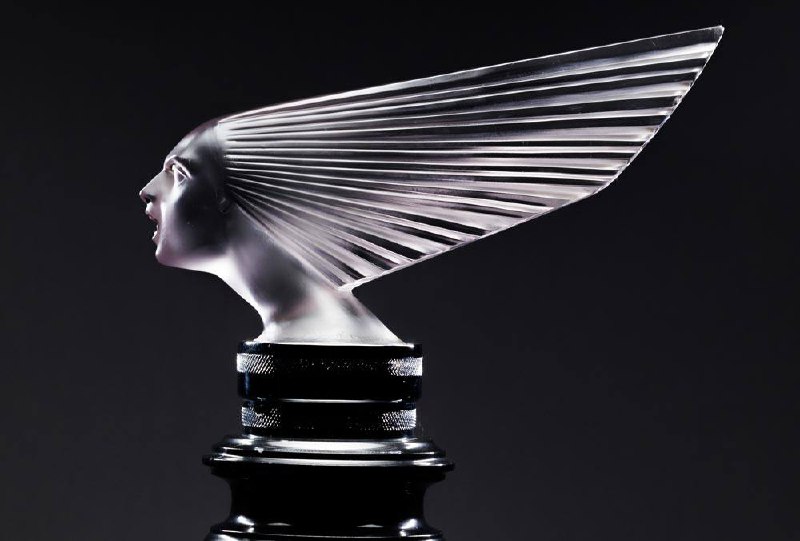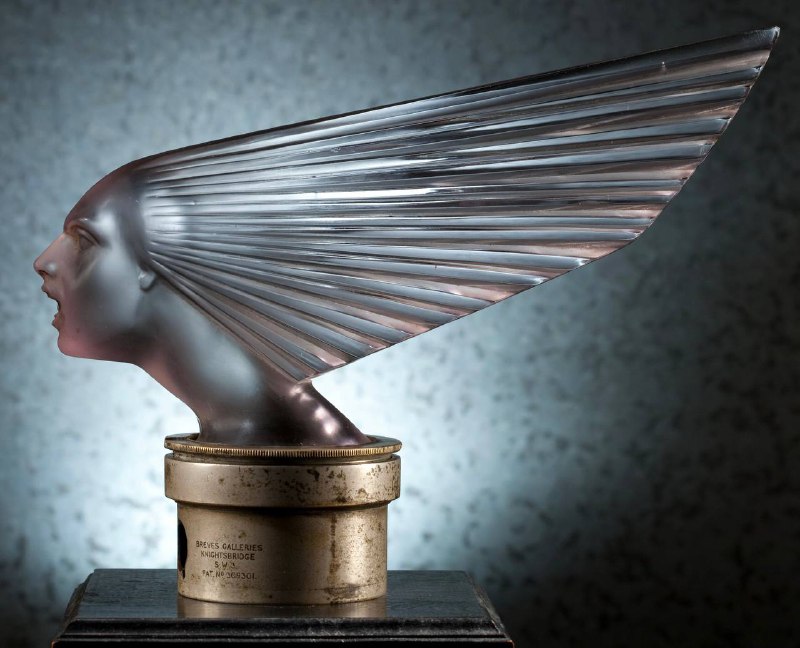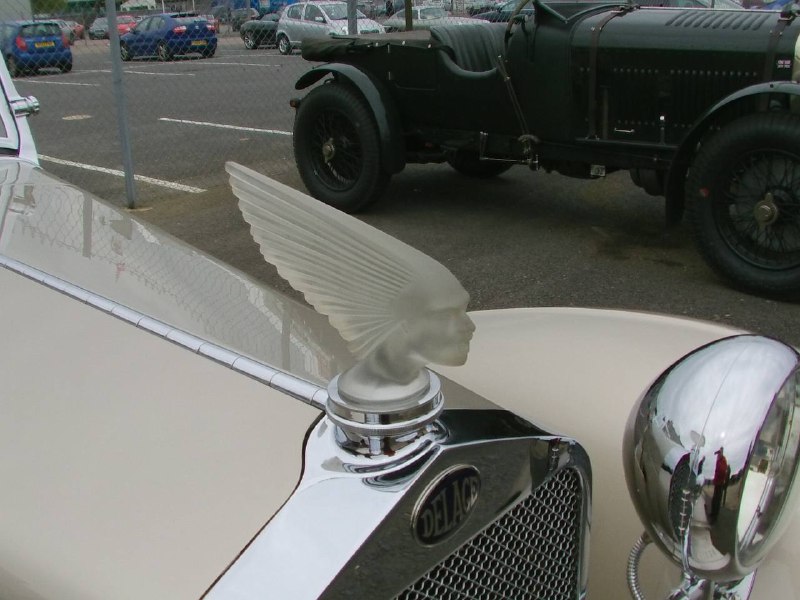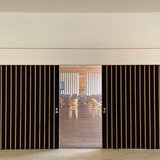В продолжение разговора о стеклянных головах не можем не поделиться историей о Рене Лалике, который так вдохновил Веру Мухину. В 1925 г. Рене Лалик начал создавать маскотов, стеклянные фигурки для украшения капотов автомобилей, и в следующие шесть лет изготовил целых тридцать статуэток, в том числе, пожалуй, самую знаменитую фигурку «Victoire». Последняя была создана в 1928 г. и была посвящена десятилетию Компьенского перемирия, заключенного 11 ноября 1918 г. Плоть от плоти ар-деко, эта фигурка в то же время предвосхитила поголовное увлечение обтекаемыми формами, ставшее известное вскоре как «стримлайн-модерн». Интересно, что, хоть маскотами Лалика предполагалось украшать любые автомобили, в чертах этой скульптуры угадываются отсылки к головам индейских вождей, которыми в то же время украшал капоты своих автомобилей американский «Понтиак» (фото 6).
P.S. Фигурка Лалика быстро распространилась за пределы Франции: в частности, в Великобритании компания «Breves» продавала ее под названием «Дух ветра» и предлагала покупателям версию с подсветкой, установленную на запатентованное ею основание. В 1930-х гг. украшение радиаторов фигурками было признано небезопасным для пешеходов, и Рене Лалик преобразовал своих маскотов в пресс-папье, ограничители для книжных полок и просто домашний декор…
———
Circling back to our post on Vera Mukhina’s glass sculptures, we cannot help sharing a note on René Lalique the Soviet sculptor was so inspired by. In 1925, Lalique set himself to design a series of car mascots, glass ornaments for radiator caps, and, in the next six years or so, produced thirty mascots including the most famous one called Victoire and designed in 1928 to commemorate the 10th anniversary of the Armistice of Compiègne, which was signed on November 11th, 1918. Exemplifying the spirit of Art Deco, this figurine was also a forerunner of Streamline Moderne, a variety of Art Deco that emerged in the early 1930s. Of note, even though Lalique’s mascots were not make-specific and could be used on basically any car, the detailing of Victoire is reminiscent of the sculptures of Indian chieftains Pontiac decorated their vehicles at around the same time in the US (see pic. 6).
P.S. Lalique’s mascot was soon commercially available outside of France. In the UK, Breves of Knightsbridge sold it as “Spirit of the Wind”, offering a patented illuminated version thereof. In the 1930s, car mascots were deemed unsafe for pedestrians and Lalique quickly adapted his sculptures to be used in household settings as bookends, paperweights, or purely decorative items…
(photos: Flickr users Roy Cousins, Theunis Viljoen, bonhams.com, hutchinsonscott.co.uk, fineart.ha.com, fr.lalique.com, rlaliquemascots.com, musee-lalique.com, thejbscollection.com)
P.S. Фигурка Лалика быстро распространилась за пределы Франции: в частности, в Великобритании компания «Breves» продавала ее под названием «Дух ветра» и предлагала покупателям версию с подсветкой, установленную на запатентованное ею основание. В 1930-х гг. украшение радиаторов фигурками было признано небезопасным для пешеходов, и Рене Лалик преобразовал своих маскотов в пресс-папье, ограничители для книжных полок и просто домашний декор…
———
Circling back to our post on Vera Mukhina’s glass sculptures, we cannot help sharing a note on René Lalique the Soviet sculptor was so inspired by. In 1925, Lalique set himself to design a series of car mascots, glass ornaments for radiator caps, and, in the next six years or so, produced thirty mascots including the most famous one called Victoire and designed in 1928 to commemorate the 10th anniversary of the Armistice of Compiègne, which was signed on November 11th, 1918. Exemplifying the spirit of Art Deco, this figurine was also a forerunner of Streamline Moderne, a variety of Art Deco that emerged in the early 1930s. Of note, even though Lalique’s mascots were not make-specific and could be used on basically any car, the detailing of Victoire is reminiscent of the sculptures of Indian chieftains Pontiac decorated their vehicles at around the same time in the US (see pic. 6).
P.S. Lalique’s mascot was soon commercially available outside of France. In the UK, Breves of Knightsbridge sold it as “Spirit of the Wind”, offering a patented illuminated version thereof. In the 1930s, car mascots were deemed unsafe for pedestrians and Lalique quickly adapted his sculptures to be used in household settings as bookends, paperweights, or purely decorative items…
(photos: Flickr users Roy Cousins, Theunis Viljoen, bonhams.com, hutchinsonscott.co.uk, fineart.ha.com, fr.lalique.com, rlaliquemascots.com, musee-lalique.com, thejbscollection.com)
3❤44🔥16👍14
group-telegram.com/midcenturymodern/17258
Create:
Last Update:
Last Update:
В продолжение разговора о стеклянных головах не можем не поделиться историей о Рене Лалике, который так вдохновил Веру Мухину. В 1925 г. Рене Лалик начал создавать маскотов, стеклянные фигурки для украшения капотов автомобилей, и в следующие шесть лет изготовил целых тридцать статуэток, в том числе, пожалуй, самую знаменитую фигурку «Victoire». Последняя была создана в 1928 г. и была посвящена десятилетию Компьенского перемирия, заключенного 11 ноября 1918 г. Плоть от плоти ар-деко, эта фигурка в то же время предвосхитила поголовное увлечение обтекаемыми формами, ставшее известное вскоре как «стримлайн-модерн». Интересно, что, хоть маскотами Лалика предполагалось украшать любые автомобили, в чертах этой скульптуры угадываются отсылки к головам индейских вождей, которыми в то же время украшал капоты своих автомобилей американский «Понтиак» (фото 6).
P.S. Фигурка Лалика быстро распространилась за пределы Франции: в частности, в Великобритании компания «Breves» продавала ее под названием «Дух ветра» и предлагала покупателям версию с подсветкой, установленную на запатентованное ею основание. В 1930-х гг. украшение радиаторов фигурками было признано небезопасным для пешеходов, и Рене Лалик преобразовал своих маскотов в пресс-папье, ограничители для книжных полок и просто домашний декор…
———
Circling back to our post on Vera Mukhina’s glass sculptures, we cannot help sharing a note on René Lalique the Soviet sculptor was so inspired by. In 1925, Lalique set himself to design a series of car mascots, glass ornaments for radiator caps, and, in the next six years or so, produced thirty mascots including the most famous one called Victoire and designed in 1928 to commemorate the 10th anniversary of the Armistice of Compiègne, which was signed on November 11th, 1918. Exemplifying the spirit of Art Deco, this figurine was also a forerunner of Streamline Moderne, a variety of Art Deco that emerged in the early 1930s. Of note, even though Lalique’s mascots were not make-specific and could be used on basically any car, the detailing of Victoire is reminiscent of the sculptures of Indian chieftains Pontiac decorated their vehicles at around the same time in the US (see pic. 6).
P.S. Lalique’s mascot was soon commercially available outside of France. In the UK, Breves of Knightsbridge sold it as “Spirit of the Wind”, offering a patented illuminated version thereof. In the 1930s, car mascots were deemed unsafe for pedestrians and Lalique quickly adapted his sculptures to be used in household settings as bookends, paperweights, or purely decorative items…
(photos: Flickr users Roy Cousins, Theunis Viljoen, bonhams.com, hutchinsonscott.co.uk, fineart.ha.com, fr.lalique.com, rlaliquemascots.com, musee-lalique.com, thejbscollection.com)
P.S. Фигурка Лалика быстро распространилась за пределы Франции: в частности, в Великобритании компания «Breves» продавала ее под названием «Дух ветра» и предлагала покупателям версию с подсветкой, установленную на запатентованное ею основание. В 1930-х гг. украшение радиаторов фигурками было признано небезопасным для пешеходов, и Рене Лалик преобразовал своих маскотов в пресс-папье, ограничители для книжных полок и просто домашний декор…
———
Circling back to our post on Vera Mukhina’s glass sculptures, we cannot help sharing a note on René Lalique the Soviet sculptor was so inspired by. In 1925, Lalique set himself to design a series of car mascots, glass ornaments for radiator caps, and, in the next six years or so, produced thirty mascots including the most famous one called Victoire and designed in 1928 to commemorate the 10th anniversary of the Armistice of Compiègne, which was signed on November 11th, 1918. Exemplifying the spirit of Art Deco, this figurine was also a forerunner of Streamline Moderne, a variety of Art Deco that emerged in the early 1930s. Of note, even though Lalique’s mascots were not make-specific and could be used on basically any car, the detailing of Victoire is reminiscent of the sculptures of Indian chieftains Pontiac decorated their vehicles at around the same time in the US (see pic. 6).
P.S. Lalique’s mascot was soon commercially available outside of France. In the UK, Breves of Knightsbridge sold it as “Spirit of the Wind”, offering a patented illuminated version thereof. In the 1930s, car mascots were deemed unsafe for pedestrians and Lalique quickly adapted his sculptures to be used in household settings as bookends, paperweights, or purely decorative items…
(photos: Flickr users Roy Cousins, Theunis Viljoen, bonhams.com, hutchinsonscott.co.uk, fineart.ha.com, fr.lalique.com, rlaliquemascots.com, musee-lalique.com, thejbscollection.com)
BY Mid-Century, More Than










Share with your friend now:
group-telegram.com/midcenturymodern/17258
